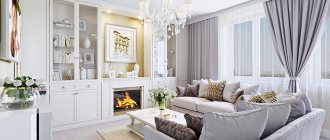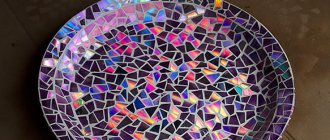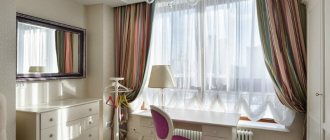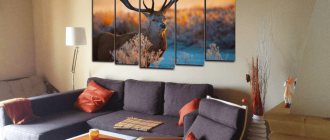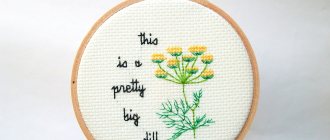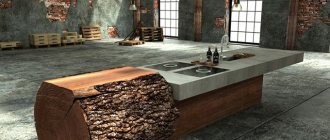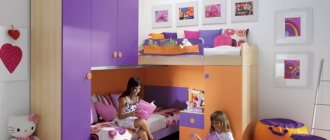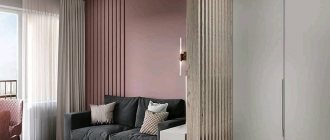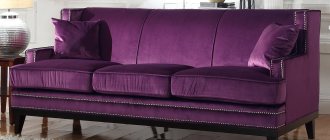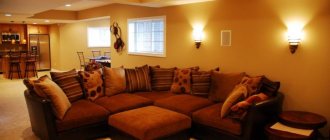Origin
Once upon a time, baguettes were the name given to carved planks of wood that were used exclusively for the manufacture of picture frames. Gradually, the area of its application expanded, and today this concept includes:
- baseboard;
- molding;
- platbands;
- fillets.
With the help of these types of baguettes, space is organized in the interior, walls and ceilings are decorated, openings are designed, and, in general, accents are placed.
Doorway decor with baguette
Kinds
The range of modern moldings is quite diverse. Some in appearance are almost identical to the baguettes of bygone times, despite the fact that they are sometimes made from pure synthetics. Others, with their metallic shine, are associated with space technology. Look at the photos of baguettes in the interior: you will not find two identical solutions. Today, wood, foam plastic, gypsum and more are used to make planks. Each material is good in its own way, but it is still useful to know its leading characteristics. This will help you choose a molding of exactly the right quality for your interior, which will fit into the overall style and will not spoil the impression of the renovation in a few months. So, let's get acquainted.
Baguette in the interior
Wooden baguettes
Wood is considered a material that can bring unique comfort and special coziness to the environment. Ceiling fillets are often made from it. But wooden baguettes in the interior are responsible not only for decorative purposes, but also for creating a healing microclimate. Products made from spruce and pine do an excellent job with the latter task. Baguettes made from them are good in all respects, including price. However, they are not allowed into luxury apartments. Here we need something more luxurious, raising the prestige of the interior to stratospheric heights. Compare how baguettes in the interior look in the photo, made from coniferous wood, and walnut or cherry. The difference will be quite noticeable. What can we say about friezes made of mahogany and similar materials!
Wooden baguettes will bring special comfort
But let's return to the original characteristics. The positive qualities of wooden baguettes can be considered: their environmental friendliness, ease of installation, and the ability to implement various design ideas.
Among the disadvantages, it is worth noting the low plasticity, as well as the tendency for baguettes to rot and deform in interiors with high humidity.
Wooden baguette is not suitable for wet rooms
Gypsum fillets
The products do not have the disadvantages of wooden structures. Today they are often used to decorate rich interiors, where complex design developments need to be implemented. Often, a gypsum frieze has the appearance of highly artistic stucco molding, and therefore can make the decor elegant and expensive. Look at the photo to see what a gypsum molding looks like in the interior.
Gypsum baguette in the interior
The advantage of working with gypsum is the ability to cast fillets of any decorative complexity from it.
Among the disadvantages, the large weight of such baguettes and their fragility should be noted. This forces us to invite professional builders to install the decor.
Plastic moldings
This quality baguette in the interior often complements plasterboard ceiling structures and frames suspended ceilings. Externally, it is a plank with locking grooves. The product is mainly produced in white. This is convenient as it allows you to adapt the finish to any interior palette. On sale you can also find decorative moldings that imitate the texture of wood and marble.
Plastic ceiling molding
Plastic models are lightweight, inexpensive, and aesthetically pleasing. The latter is clearly demonstrated by the photos of baguettes in the interior. In addition, the moldings are characterized by a homogeneous structure, are not afraid of ultraviolet radiation, are not prone to fading, and do not rot. They are easy to cut, easy to adjust and are ready to serve for centuries.
Plastic baguette has a long service life
Aluminum baguettes
Light metal structures are used in the decoration of modern interiors. Such a baguette is especially relevant in high-tech, pop art, and avant-garde, where there is a need to refine curved forms. In the interior, not only ceilings or walls are “dressed” with aluminum molding: they decorate mirrors, posters, and photographs.
Aluminum baguette fits perfectly into a modern interior
Foam moldings
The product is enviably popular due to its low cost and good decorative qualities, but do not delude yourself. A foam baguette is a temporary solution, as the material tends to crumble. The decor itself loses its attractiveness and spoils the appearance of the rest of the decor.
Foam moldings can crumble over time
Polyurethane fillets
A very popular material. Unlike plaster and wood, polyurethane is lightweight, but this does not prevent it from being durable; a polyurethane baguette that appears in the interior can last for many years. The finish is not susceptible to exposure to moisture and dry air, and its assembly does not require any specific skills. Since cornices are amazingly flexible, they can easily be mounted on ceilings of the most complex designs or assembled into intricate shapes on wall surfaces. Look in the photo for how compositions made from polyurethane baguettes will look on the walls in the interior.
Polyurethane fillets will last for many years
Friezes made from this material can withstand painting very well, so it will not be difficult to adapt them to the environment. Consumers will be pleased with the assortment of products. There are models for Art Nouveau and Classicism, Empire and Rococo.
Friezes made of polyurethane can be painted in any color
What materials are moldings for cornices made from?
The cost and appearance of the cornice primarily depend on the material of its manufacture. Based on this feature, the following types of baguettes are distinguished:
- polyurethane;
- foam;
- plastic;
- wooden;
- metal;
- plaster.
All of the above materials can be successfully used to produce aesthetically attractive, high-quality curtain rods.
Baguette cornice made of polyurethane
Polyurethane is a high-tech, elastic, lightweight polymer material widely used in construction and interior design. Flexible, durable, wear-resistant products are obtained from polyurethane. When casting, they can be given any shape. In particular, all kinds of stucco decorations (bas-reliefs, ceiling moldings) and moldings for cornices are cast from it. In addition, polyurethane models often have holes for installing cables or lighting.
Flexible plastic ceiling molding cornice
Models made of foam and plastic are the second most popular. All kinds of ornaments also look great on them; they are the ones most often used together with stretch ceilings, and are often sold with a special ceiling groove. But in quality they are significantly inferior to polyurethane ones - the plastic turns yellow, and the foam crumbles during use. The main advantage of planks made of these materials is their low cost.
Externally, all three types of baguettes look approximately the same. In addition, manufacturers have learned to paint them in different colors, including those imitating metal and wood. Curtain slats can be upholstered with fabric and decorated with colored ceramic or glass inserts.
Stylish and laconic wooden baguette cornice
Natural wood options look expensive and noble. This is a real find for classic interiors. If necessary, the wood can be painted in any color, gilded, artificially aged, or left in its natural state and varnished. Another advantage of wood is its environmental friendliness, so it is natural that its cost is higher than artificially created materials.
Metal cornice with leather finish
Metal strips are mainly made from lightweight aluminum alloy or thin sheets of stainless steel. They are very strong and durable. In mass sale, there are mainly standard models with a smooth or embossed surface. But in specialized workshops you can order a luxurious and unique forged product based on an individual project.
Gypsum options are made by hand, according to individual orders. The original plaster molding strip is distinguished by its extraordinary decorativeness, but requires careful handling and periodic restoration. The high cost and fragility of gypsum planks limits their use in residential premises. They are mainly purchased for decorating windows in art galleries, museums, theaters and similar cultural institutions.
When choosing a decorative cornice, you should definitely take into account not only your own preferences and the price of the product, but also the type of walls in the room and the material of the curtains - the heavier the fabric, the more durable the cornice should be.
Ceiling decoration
“Baguettes in the interior can be used to organize lighting”
The baguette in the interior, used in the design of the ceiling, carries a double load. His responsibilities include:
1. Mask the seam between the wall and the ceiling surface.
2. Decorate the room with yourself.
Ceiling decoration with baguette
Installing the decor is easy. The parts are placed on glue. The composition is used to treat both the part and the surface to which it will be fixed. If you want to do without cutting corners, you can buy corner molding models.
Installation of ceiling molding
Baguettes in the interior can also be used to organize lighting. This ceiling plinth is distinguished by thickening at the bottom and installation method. It is not fixed close to the surface, but at a distance of 20 centimeters from it. First, an LED strip is run along the perimeter of the ceiling. Look at the photo of baguettes in the interior, how interesting it looks.
Ceiling plinth with lighting
Color solutions
For country style and English style windows, a wooden cornice is the ideal solution. The color of the strip should contrast with the color of the walls and match the curtains (or vice versa). This option looks great in the interior of a living room or hall.
The color of the window cornice should be selected especially carefully. Disharmonious combinations can worsen the aesthetic perception of even very expensive products. The rule here is this: the color of the strip should overlap either with one of the shades of the curtain fabric, or with other interior elements. If inlay or other types of additional finishing are used, it is advisable to keep the overall concept in the same style.
In the photo, a wood-look baguette cornice matching the blinds and pieces of furniture makes the interior harmonious. Curtains that smoothly pick up the shade of the walls soften and balance the overall composition.
The classic white ceiling and the “heavy” massive baguette of the same color with a corrugated surface are perceived as a single whole.
Baguette is a universal option for making cornices. Appearing for the first time in classic interiors, today it can support any style if the material and finish are chosen correctly.
Wall design
In the finishing of these surfaces, the baguette shows all its versatility and diversity. His tasks are also ambiguous. It should either attract attention to a certain area, for example a photo gallery, or become an element of space zoning. In the latter case, it masks the joint at the transition point of different textured finishes of the sectors, which makes the interior more harmonious.
Wall decor with baguette
If you look closely at the photos of baguettes on the walls in the interior, you will probably notice the originality of the niches they decorate. This simple way manages to emphasize the architectural inclusion and present it in a mysterious and romantic way. In addition to moldings, lighting is added to the niche. The finishing touch will be the appearance of an elegant curtain made of lightweight material.
Finishing niches with baguette
It is difficult to surprise someone by filling the decor with paintings and all kinds of content with posters, so in the design of the room you need to go further and, without focusing on standard decors, leave them only as baguettes in the interior. As a frame for walls, they can be made of any material that is in harmony with the style of the overall solution.
You can make a wall composition from baguettes by collecting three or more A3 frames and fixing them at a short distance in a geometric or chaotic order. You can use the entire wall as a frame. This technique is often used in classical settings. Possible options for using baguettes on walls in the interior will be suggested by the photo.
Wall composition made of baguettes
What types of baguettes are there for curtains?
There are a large number of types of baguettes for curtains, which differ depending on the material used, the method of fastening, and the number of rows.
By appearance there are:
- decorative - in this case the plank comes separately;
- fastening - the strip goes along with the cornice.
The following materials are used to make cornices:
- natural wood;
- plastic;
- metal;
- polyurethane;
- gypsum;
- Styrofoam.
If we consider the methods of fastening, then there are two of them:
- wall-mounted models - attached to the wall using special fasteners for this purpose, which can be open or closed;
- ceiling cornices - in this case, installation is carried out directly to the ceiling.
By type of fastenings there are:
- rod - under the baguette there is a round cornice;
- strings - between the clamps there is a steel cable;
- rail – classic profile with built-in hooks.
When choosing, you should take into account the appearance of the decorative structure; this is necessary so that the selected element fits into the interior design.
Important! When installing suspended ceilings, it is recommended to first specify the desire to attach ceiling cornices.
Framing decorative elements
Everything that should make the interior lively and attractive needs design modification. Engravings, mirrors, tapestries just hanging on the walls may not convey the idea of their appearance in the setting, and will look like strangers on the walls. But you just have to frame them with a decorative baguette and they will be miraculously transformed. Accessories will take on a new meaning and fit into the space without any problems.
Pictures in a baguette will give the interior a finished look
Look at the photos for examples of using baguettes in the interior and try a simple experiment. Take a nondescript, strictly rectangular mirror and make a frame for it by simply cutting and gluing baguette strips to the surface of the appropriate size. Now put it back in place and evaluate the result. You will notice how the surrounding space will change.
Mirror framed with baguette
Materials from which baguettes are made
This decorative element can be made from the following materials:
Tree
Wooden ceiling baguettes are traditional rod structures that are attached to the ceiling with two or three brackets with a decorative strip that covers the places where curtains are attached, hooks, rings and other parts. All baguette strips come complete with end elements, which give the entire composition a finished look. Wooden baguettes are a decorative part of the ceiling cornice, which can be combined with the texture of fabrics or furniture in the room.
Metal
Metal cornices have a fairly wide range, which can be divided into groups according to type of design, manufacturing method, and material.
- Round cornices are structures of one, two or three rods that are attached to the ceiling using separate or common brackets. Smooth metal rods are reliable and practical, able to withstand heavy, long-length fabrics.
- String ceiling cornices consist of metal strings tensioned by screws built into the brackets. The only drawback of string structures is that they cannot withstand heavy fabrics or draped curtains and sag over time. But for light curtains made of voile, tulle, organza in a room with suspended ceilings, this is an ideal option with the lowest price.
- Rail ceiling curtain rods are made mainly of aluminum and are a profile with several tracks for the movement of curtains. Typically, a rail profile has a baguette strip on the front side, which can be decorated by the manufacturer or consumer.
Forged metal ceiling cornices are exclusive handcrafted elements that are custom-made for a specific room and serve as a rich decoration that matches the style of decoration.
Plastic
Plastic baguette cornices consist of a multi-row rail profile with runners. Typically the design includes a grooved PVC strip, swivels, end caps, and a plastic molding that attaches to the front edge of the cornice. The width of the baguette is selected based on the type of curtain composition, the type of fastening of the curtains and the presence of a lifting or sliding mechanism.
For any plastic cornice, you can choose or order a ceiling molding with the desired decorative surface:
- under natural wood;
- with color design;
- in the form of a stepped strip;
- in the form of a semicircular strip.
Practically, all trade organizations complete framing systems at the buyer’s request, taking into account the length, number of rotating elements, rollers and plugs.
The presence of a baguette provides an easy way to change the decor of the cornice and curtain composition - just replace the baguette strip with a new one.
Decorative baguettes
The decorative ceiling molding is made from the same material as the cornice. But often wooden baguettes have the most interesting appearance:
- semicircular or stepped;
- with bas-relief or carving;
- with an aging effect, silvering or gilding;
- with imitation stucco.
Decorative baguette strips are selected depending on the design of the curtains or the interior of the room, furniture, walls, so that the harmony of the overall interior line is not disturbed. Modern wooden baguettes are made from high-quality multi-layer plywood, which is molded if necessary. Imitation of stucco molding is performed on a wooden baguette by casting polymer materials, followed by hand painting or applying ornaments.
In rooms decorated in country style, rustic style, in bedrooms or children's rooms, cornices with baguettes that are covered with fabric are used. The fabric-covered baguette frame is attached to “soft” plastic corners, which are rigidly mounted on the cornice.
Several design tips for using baguettes in the interior
“Oversized baguettes in the interior of small rooms look ridiculous; moreover, they noticeably make the space heavier and make it look even cramped.”
The need to adjust the room space often arises. Did you know that moldings can be used to solve this problem? Narrow ceiling models will make the room taller. A baguette hung vertically along the walls will make the atmosphere stricter and more formal. When laid horizontally, it will add dynamics to the room atmosphere.
Vertical baguettes will add dynamics to the interior
Wide fillets should decorate spacious rooms. Oversized baguettes in the interior of small rooms look ridiculous; moreover, they noticeably make the space heavier and make it seem even cramped.
How often do we see photos of interiors with baguettes on the walls in relief! In order to choose something similar for your environment, focus on the color, texture and stylistic solution of the room decoration. It should be noted that white moldings are universal. They can be added to any setting with any background. If you want to use colored baguettes in the decor, then before attaching them, do a test fitting. Paint a small piece of the plank in the chosen shade, apply it to the surface and see what happens.
Colored baguette in the interior
When adding baguettes to the interior, observe moderation, take into account the design style of the space being designed, analyze what is produced by your restless imagination, and then there will be no reason to regret the effort and money spent. The resulting effect can please the eye for many years.
Advantages and disadvantages of use
The popularity of baguette cornices is natural. A convenient curtain mount has many advantages:
- The design allows you to decorate window openings with heavy curtains. Ordinary strings or thin rods do not always withstand the load and are capable of bending.
- Baguette cornices are great for decorating windows with multi-layer canvases. One row is for tulle, the second is for curtains, the third is for lambrequins.
- The rail grooves are extremely convenient for smooth sliding. So that installation work does not have to be repeated, the required number of curtain hooks is calculated in advance.
- Arranging window openings of complex configuration, be it an arch or a bay window, with plastic baguette cornices is not difficult.
- Embossed trims for curtains serve as additional interior decoration in the interior of the room.
- Ceiling structures adjust the height of the room, visually increasing it.
When purchasing a baguette strip for curtains, consider several features:
- Complex decor is not appropriate in laconic interiors. If the room is dominated by hi-tech or minimalism, get by with strict straight slats without any frills.
- Hanging curtains on wooden structures is difficult.
- Not all curtain models are suitable for decorating with baguettes. Lush scallops on French curtains distract attention. With such a fastening, straight canvases without unnecessary folds are optimally combined.
When choosing a baguette cornice, take into account the material of the structure, the optimal mounting option, compatibility of the appearance with curtains and design style. A competent approach will provide the window opening and the entire interior with an impeccable appearance.
Baguette in a stylish interior: creating a harmonious space
Today, baguette is considered the most important nuance of interior decor. An element of original design will easily fit into the overall interior concept and can even become an accent detail in the design of the space. Full compliance with the design idea will help it act as an organic addition. That is, the color scheme of the baguette, its texture, and format must be in tune with the stylistic decision of the room.
Look at the photo of baguettes in the interior. How subtly they emphasize the belonging of a style to one direction or another. You will never confuse country with baroque or modern with classic. Moreover, this finish can be used to frame not only paintings, but also:
- arch;
- mirror;
- niche;
- bookshelf;
- doorway.
Original design of bookshelves with baguette
And this is not the entire list of ideas for use. How else can you use baguettes on the walls in the interior, look at the photo, but for now let’s try to look at visual examples of decorating rooms with them, designed in the most popular styles.
Classic
The style is elegant, clearly demonstrating its wealth. To become an organic component of such an interior, a baguette must at least be a worthy embodiment of forgotten luxury. An ideal option would be a wooden baguette covered with stucco and a surface painted with gold or milk paint.
Baguette for a bedroom in a classic style
Baroque
Baguette in a Baroque interior is a symbolic element, emphasizing the wealth and social position of the owner of the house. Since the style is a kind of symbiosis of the classical direction and modernity in its best manifestations, including complexity and attraction to an abundance of small details, then the baguettes appearing in it should amaze with their high cost, luxury and beauty. Products made from precious wood can do this. How baguettes should look on the walls in a Baroque interior, look at the photo.
Baguette in a baroque interior emphasizes the luxury of the decor
Modern avant-garde
The room, decorated in an avant-garde design direction, is arrogant. It stands out for the audacity of its decisions and the courage of their presentation. Everything that appears in the setting is a screaming protest to traditions, and the main element in the destruction of habitual stereotypes will be the baguette.
Bright baguette will fit perfectly into a modern interior
An oriental frame model in a bright rich color scheme with ornamental blackening or gold embossing will fit perfectly into the decor. Look at the photos of baguettes in kitsch and trash interiors. Being simple flat, they take on the brightness of the colors. The decor can appear in scarlet and rich green tones or a colored cocktail with the effect of spilled colors, attracting with the strangeness of mixing yellow with cornflower blue and purple.
Minimalistic brevity
It will be possible to harmonize a space that tends towards asceticism with a graphic baguette. The laconicism of the frame, the simplicity of its form and maximum lightness will allow you to elevate the existing mirrors in the interior, works of contemporary painters, graphic drawings, and now fashionable photos in the retro spirit, without disturbing the basic stylistic concept.
A laconic baguette harmonizes a minimalist space
Baguette – nothing better for decoration
Architects U. Schönbergs, V. Balode Photo M. Stepanova Architects N. Weinert, V. Yuryeva Photo P. Lebedev The search for a worthy frame for your picture begins with such “corners” of the baguette and mat. Take heart: you have hundreds of options to choose from! How the finished product will look depends only on you. Designer D. Davydov Photo by V. Vasiliev. Paintings, posters, graphics - any item framed is a universal decorative element that can be combined with all styles. At the same time, no other interior detail can tell as much about its owner as a painting.
CARPET HOUSE A frame can turn out to be a completely independent design element: what is a familiar working tool for an artist, in an ordinary apartment becomes an unusual, stylish and fashionable decorative detail and a reason for pride. Architect D. Mikhailov Photo by G. Shablovsky. The combination of several paintings is a matter of taste. You can rely on the decorator or trust your personal sense of beauty
Architect U. Schenbergs Photo M. Stepanova Architect A. Belyavskaya Photo V. Vasilyev, A. Babaev. You can put many small photographs in the same area, but then you lose the feeling of calm and confidence
The most modest wooden molding will cost $1 per meter, a nicer plank will cost about $30. The price of an expensive wooden baguette starts from $100-120 per 1 linear. m Author of the project K. Abike Photo K. Manko.
Aluminum molding costs from $3 to $40 per meter; Moreover, the price directly depends on the width of the plank Architect N. Astakhova Photo D. Minkina. The mirror will become an unexpected stylish detail of the bathroom interior if framed in a wide, massive frame in a classic style
“European baguette” Architect A. Apshenieks Photo M. Stepanova. The baguette should support the overall color scheme of the painting or the TSEKH interior. It is not at all necessary to hang all the canvases on the wall, you can find a more “creative” solution... A painting “casually” leaning against the wall will create an atmosphere of light artistic disorder and a glamorous atmosphere in a fashion studio
“European baguette” “DOMOSVET” To ensure the most effective protection of the canvas from the harmful effects of lighting systems, you should definitely use lamps with protection from ultraviolet rays and infrared radiation (most lamp manufacturers have these, for example Osram or Philips) “European baguette” »
Portrait of a great-grandmother, once painted by a famous artist; slightly scandalous nudes purchased at a fashionable nonconformist opening day; photographs dear to the heart; objects of special pride - diplomas, awards and simply wonderful children's drawings - how many such precious but non-functional little things are stored in boxes and on mezzanines for each of us! It's time to take them out of dusty boxes and frame them in beautiful frames.
Great artists of different eras not only attached great importance to the correct choice of framing for their paintings, they made sketches of the elements of the frame or even made it themselves. Leonardo da Vinci, for example, believed that “the frame creates a special halo around the picture; it should not just frame it - it should be one with it.” It’s probably worth listening to the opinion of the great Leonardo and approaching the choice of frame with all seriousness. It doesn't matter what you want to frame, it's how you do it that matters. Frankly speaking, the task is not easy. On the one hand, the frame should emphasize the uniqueness and individuality of the work of art, and on the other hand, it should be a full-fledged decorative element that unites the image and the interior in which it is placed.
And if among the documents that you intend to put on public display there is no decorator’s diploma, it is better to contact a framing workshop. One of the main tasks of its employees is precisely to help you find a worthy compromise between the artistic value of the image and the requirements of the interior. In the capital alone today there are about 120 such enterprises. Moreover, every third art gallery has its own small workshops, where when you buy a painting or poster, they will make you on the spot or help you choose a frame.
Almost anything can be placed in a frame: a painting, a charcoal drawing, an old engraving, embroidery, a mirror, historical documents and letters, antique jewelry, banknotes and coins... Sometimes oilcloth numbers are placed in the frame, which are tied to the baby’s arm in the maternity hospital.
Some fans of baguette use it in the interior, framing windows and doorways, making baseboards from baguette and even imitating stucco molding on the ceiling with slats. And there are also plasma panels and aquariums built into the wall surrounded by a baguette - why not living pictures? So feel free to experiment!
There is a choice!
Currently, baguettes are imported to Russia from Western and Eastern Europe, Great Britain and the USA. Based on the results of a small survey among professional framers, the following picture emerges: in terms of design, Italy is the undisputed leader, which, in general, is not surprising. Fans of antique products will find the developments of Spanish factories, which are inclined to use elements of ancient styles in decoration, very interesting. For Great Britain, which is known in the world as a supplier of progressive design ideas, the framing business is no exception: profiles are brought from the foggy island, from which stylish frames for modern graphics are made. High-quality products from German manufacturers are excellent for simple, strict frames. At the same time, the most expensive baguette is made in Great Britain, followed in descending order by products from Germany, Italy, Spain and Russia.
In recent years, baguette factories have begun to appear in our country, offering a large selection of good and relatively inexpensive goods. So far, professionals agree that domestic manufacturers have not yet reached a high level of quality and design due to little experience, since the newest Russian baguette market is only ten years old. Today this is a very dynamic business, and at the most important international professional exhibition of framers SACA-Quadrum (held in February in the Italian city of Bologna), no one is surprised at the large number of Russian representatives. However, fashion for our consumers is still dictated by European countries.
Choosing a baguette, as already mentioned, is a responsible matter; you will have to admire the result personally. Therefore, it makes sense to take the paintings and posters that you intend to frame to the workshop: on the spot you can attach samples of frames and mats to the images and see how they fit together. This can only be done if we are not talking about very valuable works. The safety of the painting is one of the main problems of the owner. Of course, taking it outside without packaging is strictly contraindicated. Thick paper, packaging cardboard and plastic film are the best friends of a painting during its stay outdoors. An accidental, even slight blow to a canvas stretched on a stretcher instantly damages the paint layer: a noticeable dent is formed, from which, if you look at the light, spider-like cracks scatter (do not confuse them with craquelures that appear on oil painting over time - they are especially appreciated by amateurs antiques). It is quite difficult to restore damaged canvas on your own. Graphic works made on paper are sensitive to moisture, sunlight, and city dust. All this can destroy a modern work, and, especially, an antique work.
So it’s better to invite specialist framers to your home, especially if you own either a valuable or large painting, or simply don’t risk taking it to the workshop and back yourself. Some framing workshops provide full service - from employees visiting your home for measurements and delivery of the finished product to installation of the decorated picture on the wall.
Depending on the technique in which the work of art is made, as well as on its size, color, theme and other data, the method of framing, color, profile, ornament and height of the baguette are selected, first of all. Whatever you prefer - intricate motifs in the Baroque style or a strict aluminum frame - mentally “fit” it into your interior so that you won’t be surprised by the result later. If you find it difficult to choose, it is completely natural to ask the workshop staff for advice; in most cases, people with artistic education work there.
To understand what exactly and why they offer you in a framing workshop, let’s look at what a completed, designed work of art consists of, and at the same time, let’s define the terms. It is useful to know that there are certain traditions in the design of works of art. For example, paintings made on canvas with oil, tempera or acrylic paints are framed differently than, for example, graphic works. The concept of “graphics” usually refers to almost everything that is depicted not on canvas, but on paper. These can be drawings in pencil, sanguine, charcoal, pastel, including wax, ink, as well as engravings made in various techniques, prints. The value of these works lies in their uniqueness; they were made by the artist’s hand in a single copy. The presence of an author's (or non-author's) copy does not affect their value. Another thing is photographs, posters, posters, in general, circulation items. But they can also have artistic value or be simply dear to you as a memory. In any case, these images are printed on paper and also need protection and appropriate framing.
An antique painting is an item that requires special attention. Experts agree that the fewer parts that are replaced with new ones during restoration, the better the work will “feel.” For example, stretchers are very carefully strengthened, damage is restored, and repair areas are skillfully aged so that they do not stand out against the general background; They try to change old subframes only in extreme cases and with the consent of the client. The spreading canvases are carefully fixed onto the new fabric, and it is already stretched onto a stretcher. Choosing a baguette for decorating such works requires a good knowledge of the history of painting. Masters try to select decor that matches the traditions of the era in which the picture was painted (unless, of course, the customer insists on other options).
The baguette used for antique frames can contain up to 70 layers of various primers, dyes, varnishes (including expensive veneer, gilding, silvering and patina).
Traditionally, it is not customary to put paintings under glass. The dried paint layer has a rich, saturated texture, emphasizing the individuality of the artist’s hand. In addition, oil or tempera paintings can be coated with protective varnishes that have varying degrees of gloss. Professional artists and art connoisseurs rightly believe that glass “smears” all the beauty of the living surface of a painting, even if it is special, glare-free. The exception is museum paintings of special value. For example, the famous La Gioconda, kept in the Louvre, is protected by bulletproof glass. By the way, the technology for creating oil painting has been developed over centuries and is aimed at long-term preservation of paintings. Images on wooden surfaces on gesso (gesso is a special primer used in icon painting) stand the test of time especially well.
The basis of the painting is predominantly linen canvas stretched on a stretcher. The stretched canvas is covered with a primer containing chalk and various adhesives; artists sometimes create their own recipes. The image itself is applied to the dried soil. When choosing a frame, you must take into account the thickness of the subframe. And if you purchased a painting on a canvas removed from a stretcher (this happens quite often), you will also need a suitable stretcher and services for properly stretching the canvas. We do not recommend stretching the painting onto a stretcher yourself; you need to know the technology, and there is a great danger of damaging the paint layer.
But for the design of graphic works, glass is just necessary. In addition to this, you will need a passe-partout, sometimes a seal, a backdrop and, of course, a frame.
Baguette
Depending on the shape of the painting, the frame assembled from a baguette can be rectangular, round, oval, hexagonal or octagonal. A baguette is a consumable material, a plank. It varies in materials and profiles, as well as styles and colors. Materials - wood, metal (aluminum) and plastic - vary in price and consumer characteristics. The most expensive and very capricious material is wood. It is afraid of excessive moisture or dryness, and is sensitive to temperature changes. And, nevertheless, a real frame can only be made of wood - this is the unanimous opinion of all framers. The number of decor and style options for a wooden frame is almost endless: it is possible to match the frame to both original Dutch painting and modern graphics. That is why the wooden frame fits perfectly into any interior.
To make baguettes, hard (oak, apple, cherry, walnut, ramin, ayus) and soft (balsa, pine, spruce) wood species are used. Due to their dense structure, solids are less sensitive to external factors such as humidity and temperature, which provides them with a longer lifespan. They are more often used to produce thin baguettes. Wide slats are made from shy pine. Thanks to its porous structure, its wood holds mastics and special pastes well for the formation of decorative elements. Manufacturers apply up to several dozen layers of mastic to the baguette, imitating antique frames, and even dust it with artificial dust for greater authenticity. On ancient frames, the stucco molding was made of plaster, then it was primed and covered with gold or bronze.
Aluminum is the most durable and strong, but it is mainly used to produce narrow rectangular frames without a pattern. Although the design of such a baguette is not very diverse, the choice of colors is huge. Craftsmen consider aluminum more of an office material, offering it as frames for documents, diplomas, strict graphics, and photographs. Aluminum in the house, in their harsh opinion, is only suitable for interiors in the high tech or minimalist style. Plastic is an inexpensive and versatile material; the variety of ornaments and sizes of plastic baguette is not limited. In addition, plastic frames are lighter than wooden frames, and can look the same, down to the details (not every buyer can distinguish a wooden frame from a plastic one by eye, although the latter has a “soapy” sheen). From the point of view of professionals, the main disadvantage of this “soulless and cold” material is its artificial nature and “inability to serve as a worthy frame for real works of art.” For really large paintings, plastic should not be used: by definition, it is a fairly flexible material, which means it can deform over time. But for wet rooms - bathroom, kitchen - it is suitable because it is not afraid of moisture and temperature changes.
The profile of a baguette is a silhouette that is visible on the cross section of the plank. Profiles are divided into classic, reverse and flat. The classic profile creates the effect of perspective into the picture. Accordingly, the reverse profile gives the opposite effect, as if “pushing” the image onto the viewer. And a flat profile - a frame made of a simple decorative strip - does not provide any “special effects”.
In conclusion, one more “subspecies” of baguette should be mentioned. An edging, or slip, is a very narrow baguette that creates an additional thin frame between the main frame and the mat or between the mat and the image. A slip is used if it is necessary to complicate the visual perception of a work of art.
It’s quite easy to calculate the length of a baguette for a rectangular frame yourself. The picture is measured along the perimeter, then the width of the baguette is added to the length, multiplied by 8 (this is necessary because to form 45 angles, 8 corner pieces are cut from the baguette strips, which is why the internal dimensions of the frame are reduced). Let's say, if a painting with a size of 70100 cm requires a baguette with a width of 15 cm, the calculation is as follows: 7070100100(158) = 460 cm.
Glass
Glass protects the artwork from environmental influences and simply gives the work a neat, finished look. In most workshops you will be offered a choice of several types of glass: regular, non-glare matte, museum and Krilex. Standard thickness is 2mm.
Thanks to polishing, ordinary glass becomes almost perfectly smooth and transparent. And yet this is really ordinary glass that glares, reliably captures fingerprints and quite clearly reflects what is happening around it, especially when the image it covers is dominated by dark tones. However, this is the cheapest type of glass (up to 250 rubles per 1 m2) and therefore the most popular. Moreover, properly installed light and basic wiping of the glass can reduce the disadvantages to nothing.
Non-glare frosted glass is cheaper than museum glass, but more expensive than regular glass. Thanks to special processing, it does not glare. However, the same treatment gives the glass a slight whitish tint. To prevent the picture from appearing cloudy, craftsmen recommend placing this glass close to the image, directly on the sheet, without an intermediate layer of mat. But if we are talking about drawing with charcoal, sanguine or pastel, this option will have to be abandoned. A square meter of such glass will cost the buyer 650 rubles.
Museum non-reflective glass (used, as the name suggests, in museums and galleries) is free from all the above-mentioned disadvantages: it is not noticeable in the picture, and it does not glare. Also protects your work from the harmful effects of ultraviolet rays. The cost of 1 m2 of museum glass is off the charts at $200.
Krilex is a safety glass that is more common among professional artists and photographers who have to transport works (for example, for display at exhibitions) with the risk of damage during transportation. Krilex is made on the same principle as triplex: 2 layers of glass fused with a polymer film; when broken, it is showered with non-sharp fragments that cannot cut the sheet. If you have a need for this particular type of glass, then its cost starts from 350 rubles per 1 m2. By the way, broken glass is another threat to the integrity of a work of art.
Passepartout
A passe-partout is a sheet of thick cardboard with a cutout in the middle, which serves as an additional framing element of the graphic sheet. Passepartout performs not only decorative, but also protective functions: it emphasizes and shades the image, gives it emotional depth and visually separates it from the baguette. The protective function of the mat is to prevent the drawing from being pressed against the glass, especially when “close contact” can damage the image (for example, if it is made with pastel). For the most valuable works, museum mats are used - cardboard made from 100% cotton and not containing any harmful impurities. The cost of a museum passe-partout varies from 360 to 1,100 rubles or more per sheet measuring 10,080 cm.
Samples of cardboard for matting are usually displayed in the workshop's receiving area. Cardboard can be plain (the color of the front side and the cut are the same) and colored (the cut is different in color from the top layer). The standard sheet thickness is 1.5mm, but it can vary from 1 to 10mm. It’s interesting that several sheets of mat of different sizes and thicknesses can be inserted into one frame, resulting in a three-dimensional design.
Seal and back
If you are framing an image on thin paper that does not hold its shape, you will definitely need another sealing layer. Thin foam board is used for this purpose. Photos, posters, posters, cards, children's drawings are glued to it on a special machine without wrinkles or air bubbles.
At the compaction stage, workshops offer to laminate the work; the resulting layer will not only perfectly protect it from the effects of the external environment, but can even replace glass.
Most workshops do several types of lamination - from the simplest to textured, creating the effect of canvas or crumpled paper. You will have to pay for a “set of services” for compaction and lamination from 900 rubles per 1 m2.
Embroidery on fabric or batik, if it is not antique work, can be applied to foam board and even laminated if such an idea arises. Valuable fabric items are stretched onto rigid cardboard or a stretcher, like canvas, and protected from accidental creases and deformation. The cardboard on the back of the framed picture is called the backdrop. It serves to ensure the safety of the canvas, protecting it from dust and moisture. For the backdrop, corrugated cardboard is used (from 16 rubles per 1 m2) or thick cardboard (from 18 rubles per sheet 12080 cm). But the production technology requires them to contain acidic additives that are harmful to the canvas, so oxide-free museum cardboard is used for valuable products. For greater protection, the internal joint between the frame and the back is taped with special tape.
If the back side of the canvas contains a valuable autograph of the artist or an inscription dear to the heart, you can use Krilex as a backdrop instead of cardboard: safety glass allows you to see the autograph and does not allow dust to pass through.
Total
Each buyer chooses the “set of components” that is personally interesting to him. The cost of the finished product will directly depend on which set you choose and how complex the order turns out to be. To make it a little clearer how much a visit to a framer can cost, we suggest that you familiarize yourself with the offers of two workshops of different levels. For a graphic drawing on a sheet of A4 paper (2129.7 cm), design options were proposed and the minimum, average and maximum costs were calculated.
Workshop A.
Economy option:
simple glass, without mat, simple backdrop, plastic frame. Price - up to 300 rubles.
Middle option:
ordinary polished glass, simple passe-partout, thin wooden frame. Price - up to 750 rub.
Expensive/antique
option: museum glare-free glass, museum mat, archival cardboard backdrop, wooden frame (gold leaf or expensive veneer, patina). Price - 2000 rub. and higher.
Workshop B.
Economy option:
simple frame, regular polished glass, corrugated cardboard backdrop. Price - from 300 rub.
Middle option:
frame, passe-partout of the middle price category, regular polished glass, back made of thick cardboard.
Price - from 600 rub. Expensive option:
any set starting from 1200 rubles.
Suspension systems
Good quality workshops offer systems for hanging paintings in the interior. The standard kit includes a 1.5 m long fastening rod, four 15-30 cm fishing lines with metal clamps, a cable and several hooks. With a starting price of $35, such a set is a very profitable purchase. Judge for yourself. The rods are available in different colors and sizes. Transparent fishing line, regardless of its thickness, is almost invisible between paintings; and if there is excess fishing line left, the excess is simply wound up and hidden behind the last hanging frame.
The telescopic rod, consisting of two parts, is mounted on both the ceiling and the wall. Moreover, one half is securely fastened, and the second half is “put on” from the side. The fishing line clamps are installed inside the rod with one movement of the hand; hooks are placed on the fishing lines at the rate of one hook for one picture. All is ready. We take a picture, hang it by a rope on a hook, and we get a ready-made art gallery at home. The strength of the structure and the length of the fishing line make it possible to cover the entire wall plane from floor to ceiling with paintings.
Illumination of paintings
The final touch that will adequately complete the process of creating a home gallery is illumination of the paintings. If you have started a renovation and already have a number of works of art that you want to hang on the walls, it is better to designate places for them in advance. Those who plan to install it will be able to install hidden electrical wiring in the wall. If you don’t take care of this in advance, there is only one way out - a lighting system, bus or on cables. Most often it has to be attached to the ceiling.
Above a single picture hanging on the wall, special lamps on two “whiskers”, adjustable in several planes, are usually placed. Lamps are designed for one or two lamps, which allows them to be used to illuminate both small paintings and large canvases (the length of the lamp reaches 120cm). The adjustment makes it possible to illuminate the image evenly and effectively. It is recommended to place the light source at a distance of 25-50cm from the painting.
Systems for hanging large numbers of paintings require more complex lighting. Here, the ideal solution would be a bus system with several adjustable sources (we wrote about them in detail in the article
“Sunset in a heavenly frame.”). The bus is mounted on the ceiling parallel to the suspension rod, and each lamp is adjusted to its “own” picture so as to evenly cover its entire area. If you deliberately install a bus with several switching groups (that is, with the ability to switch on individual lamps independently of each other), you can “play” with the collection, lighting different pictures.
General recommendations for lighting: it should be well adjusted, installed at a sufficient distance from the image, with lamps that are harmless to the canvases. It is preferable to use lamps with fluorescent lamps: firstly, they do not heat up during operation, which means they will not harm the painting. Secondly, fluorescent lamps come in different colors, that is, they emit light with a predominance of some particular color of the spectrum, which makes it possible to enhance or, conversely, weaken the color scheme of the picture. It is advisable to place halogen lamps at the maximum distance from the canvas; they heat up during operation. As for incandescent lamps, they can only be used with a reflector - on the lamp or on the lamp itself (so-called “mirror” lamps).
The editors thank , “European Baguette”, “Domosvet”, “VERANDA ART GALLERY”, “ITALMATIC” for their assistance in preparing the material.
Unusual ideas for using baguette in the interior
Human imagination is tireless and the constant search for new solutions sometimes produces unexpected results. There are also many interesting developments regarding baguettes. For example, today such a design technique as decorating door and window openings with baguette is gaining popularity. It turned out to be an excellent alternative to platbands and harmonizes wonderfully with the window frame. How a baguette looks in this role in the interior, look at the photo.
Decorating window openings with baguette
Another non-trivial use of the material is the design of aquariums. Moldings imitating wood favorably emphasize the decorative nature of a home pond and bring contemplators of beauty even closer to nature.
Baguette emphasizes the decorative effect of the aquarium
The ceiling molding duplicated by one more line looks simply amazing. The technique is incredibly impressive, but it can only be used in apartments with high ceilings.
How it's done? Look at the photos of baguettes on the walls in the interior. 5-10 centimeters are removed from the ceiling trim and an additional thin, even, light-colored strip of moldings is placed around the perimeter of the room. The unobtrusive composition looks elegant and adds nobility to the interior, without going beyond laconic restraint.
Duplicated baguette for rooms with high ceilings
Types of baguette curtain rods
Baguette cornices add grace and elegance to the window opening, hiding the structure on which the curtain is hung. This addition will fit into absolutely any interior. However, in order to choose the most suitable option for yourself, you need to decide on the type of such decorative strip.
Types of baguette cornices according to their purpose:
- Fastening cornices are used to install curtains on a suspended ceiling. Such products are not only aesthetic, but also functional.
- Decorative baguettes are needed only to hide the unaesthetic cornice. Such planks add neatness and elegance to the interior, but do not serve any practical function, they only have a decorative role.
With this type of fastening everything is simple. If you prefer suspended ceilings, then the first option will suit you; for standard apartments, choose the second.
Baguettes are also divided according to the type of fastening:
- Wall moldings are mounted above the window frame. They need an additional bracket that will carry the curtain to the required distance. Such designs cannot be used for small windows, as they visually make them even smaller.
- Ceiling baguettes are mounted on the ceiling. They do not need to be equipped with a bracket; their design allows you to hang the curtain at the desired level. Such designs can be used not only to decorate window openings, they will be an excellent option for zoning space.
Baguettes for cornices can be made from a variety of materials. However, the most popular are plaster, metal, plastic and wooden models. Such structures can be painted in absolutely any color, which makes it easier to combine the baguette with the interior of the room.
Also, a hidden cornice in a suspended ceiling would be an excellent solution for interior decoration. Advice from professionals on our website:
